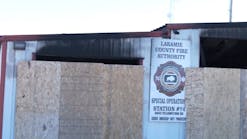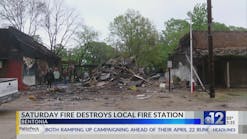You pay a visit to your friendly local library. You find your way to the “tell me what’s ever been written about a particular subject” section. You sit down in front of a blank screen and enter “FIRE DEPARTMENT CUSTOMER SERVICE.” You bravely hit the “search” button. The machine springs to life. You hear the clutch clutching, the whirley-gig whirling ... the supercharger kicks in ... the lights dim in the building, the machine sputters and shakes, the screen flickers, lights up and shows: “NO SUCH SUBJECT.”
You become anxious and bewildered. You obviously require clinical intervention. A sofa visit to your shrink clearly indicates you should develop a hobby and stop asking dumb machines dumb questions. You begin to macrame athletic supporters for B shifters. Your stress vanishes. Life is good.
This lack of documentation about what seems should be a fairly major topic is a curious reality for an occupation that has been intensely and continuously serving customers for the past 200 years. Most firefighters come from the factory with a strong action orientation and a natural inclination to focus more on the hard technical-tactical part of the job, rather than on the soft human stuff. That may explain why, up until now, even though we basically have done a good job with our customers, we have pretty much skipped talking, teaching and certainly writing about the human aspect of service delivery.
Our service just naturally evolves through stages of development. Over the past two decades, we have discovered, implemented and internalized significant improvements in the service we deliver. The equipment, software and hardware we use to deliver those services is more advanced and most importantly of all, we have made major investments in increasing the skill level, understanding and overall capability of our human resources — our firefighters.
A new character shows up in this material — Mrs. Smith. She really is not new; actually, she has been around as long as we have. It’s just in the past we have never very effectively included her in our thoughts, planning and operations in the special way that makes her our customer. She represents the real-live people who call us for help when something burns, hurts or breaks. A lot of both her immediate and her long-term future depends on how we respond to her call for help, and how we treat her during our time together. I believe she (the customer) should begin to play the central role in both our personal and professional (occupational) mentality and in our organizational service delivery game plan.
Today in the fire service, it’s pretty easy to get distracted and lose track of why we are in business. It can be useful for us to look back at the very beginning of our service to see why we are what we are.
It all started with a smart aleck named Ben Franklin, who thought up a lot of answers to problems of his day. As ol’ Ben hung out and watched the local color, he quickly identified that in those days there wasn’t any organized community response when an unfriendly fire would visit a citizen. The typical outcome was that the fire would wreck everything and everybody that could not get out of its way. Ben basically invented the American fire service, as we know it today, to respond to the urgent needs of our ancestors who were threatened by fire.
What he started then is pretty much still in place now. Based on the urgency of a fire event, he recognized that short response time capability is always a big deal, so he designed a highly decentralized system with fire stations located throughout the community. He recruited highly action-oriented, intrepid firefighters who were (and still are) attracted to the excitement of responding to emergency episodes. He formed fire companies who instantly developed pride in their unit, responsibility for their first-due area, and became highly competitive (sometimes nuts) with each other. He connected the companies with a semi-military organization and command structure. He developed an alarm and dispatch system with quick and easy access.
The beauty of his firefighting system was that it was very simple — when citizens (customers) had fires where they didn’t want them, they contacted Ben and his merry band of fire extinguishers, who responded quickly and operated to evict the fire. They solved the problem and were nice to the citizens before, during and after the fire. Ben’s basic design set the stage for virtually all subsequent American fire service development and has produced a 200-year-old love affair between the fire service and our customers.
Predictably, since Ben’s initial brainstorm, a lot of fire service change has occurred. Technology has shifted and we now use computers instead of bells, 8V92 diesel engines instead of human and horse-powered pullers and pumpers, self-contained breathing apparatus (SCBA) instead of wet beards (!), and eight-watt portable radios instead of speaking trumpets. Current codes, standards, regulations, financial management (and mismanagement), labor and community relations, politics, instant electronic communications, liability, lots of lawyers and every conceivable special-interest group have also created a lot more complex operational and management setting (progress?).
Ben’s original system design (decentralized/quick/ action oriented) has also placed us in an ideal position to expand our service delivery menu to deliver other essential urgent services — emergency medical service, hazmat, special operations, technical rescue, and an entire array of other community, social and customer service responses. This service delivery expansion has now pretty much filled up our activity dance card.
While changes in technology, the current environment, our service delivery menu and organizational complexity have created huge differences in our business, the most important element has not changed — the relationship and feeling between the customer who has a problem and the firefighter who responds to solve that problem. If we screw up that intense relationship (for any reason), both the firefighter and the customer can be in big trouble. Ben’s original system design continues to send that timeless message in a very practical way. The most profound evidence of our existence to the customer is that we show up when they are having a bad day and call us for help.
Based on that reality, being a firefighter involves making a promise to the customer that we will respond to their call and do our very best. If we become so modern, so distracted or so overcome with our own qualifications and importance that we lose sight of that promise and can’t get that vision back, we should make an adjustment in our fire service vocation/avocation and go sell aluminum siding to people who live in brick houses.
Alan Brunacini, a Firehouse® contributing editor, has been a member of the Phoenix, AZ, Fire Department for 38 years and has been the fire chief for the past 18 years. This article is excerpted from his book, Essentials Of Fire Department Customer Service, available from Fire Service Publications, 800-654-4055.




